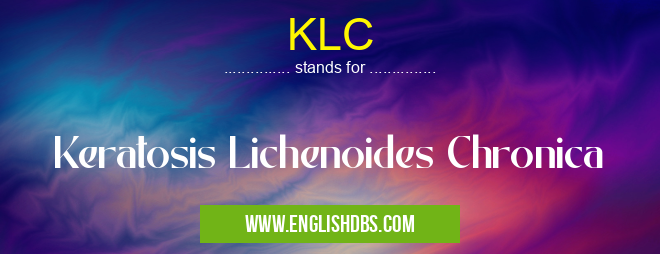What does KLC mean in UNCLASSIFIED
Keratosis Lichenoides Chronica (KLC) is a rare skin condition characterized by the presence of small, lichenoid papules and plaques. It is a chronic condition that can affect both children and adults. The exact cause of KLC is unknown, but it is thought to be related to an immune system disorder.

KLC meaning in Unclassified in Miscellaneous
KLC mostly used in an acronym Unclassified in Category Miscellaneous that means Keratosis Lichenoides Chronica
Shorthand: KLC,
Full Form: Keratosis Lichenoides Chronica
For more information of "Keratosis Lichenoides Chronica", see the section below.
Symptoms
- Small, lichenoid papules and plaques: These lesions are typically pink or red in color and can range in size from 2 to 5 mm in diameter. They are often itchy and may be accompanied by scaling or crusting.
- Distribution: KLC lesions can occur anywhere on the body, but they are most commonly found on the trunk, arms, and legs.
- Other symptoms: In some cases, KLC can also be associated with other symptoms, such as fever, fatigue, and joint pain.
Diagnosis
The diagnosis of KLC is based on the clinical appearance of the skin lesions and a biopsy of the affected skin. A biopsy can help to rule out other conditions that can cause similar symptoms, such as psoriasis or eczema.
Treatment
There is no cure for KLC, but treatment can help to relieve symptoms and improve the appearance of the skin. Treatment options may include:
- Topical corticosteroids: These medications can help to reduce inflammation and itching.
- Oral medications: Oral medications, such as methotrexate or azathioprine, can be used to suppress the immune system and reduce the severity of the condition.
- Phototherapy: This treatment involves exposing the affected skin to ultraviolet light. Phototherapy can help to reduce inflammation and improve the appearance of the skin.
Essential Questions and Answers on Keratosis Lichenoides Chronica in "MISCELLANEOUS»UNFILED"
What is Keratosis Lichenoides Chronica (KLC)?
KLC is a rare, chronic skin condition characterized by persistent, itchy, red-brown papules and plaques on the trunk, arms, and legs. It is a type of parakeratosis, which means there is an abnormal accumulation of keratin in the skin.
What causes KLC?
The exact cause of KLC is unknown, but it is thought to be an immune-mediated disorder. It is not contagious.
What are the symptoms of KLC?
The main symptom of KLC is a rash of small, red-brown papules and plaques. The rash is typically itchy and can be located anywhere on the body, but it most commonly affects the trunk, arms, and legs. Other symptoms may include fatigue, weakness, and joint pain.
How is KLC diagnosed?
KLC is diagnosed based on the appearance of the rash and a biopsy of the skin. A biopsy is a procedure in which a small piece of skin is removed and examined under a microscope.
How is KLC treated?
There is no cure for KLC, but treatment can help relieve symptoms and improve the appearance of the skin. Treatments may include topical corticosteroids, oral medications, and phototherapy.
What is the prognosis for KLC?
The prognosis for KLC varies. In some cases, the rash may resolve on its own within a few months or years. In other cases, the rash may persist for many years. Treatment can help improve the quality of life for people with KLC.
Final Words: KLC is a rare skin condition that can cause significant symptoms. The exact cause of KLC is unknown, but it is thought to be related to an immune system disorder. Treatment can help to relieve symptoms and improve the appearance of the skin, but there is no cure.
KLC also stands for: |
|
| All stands for KLC |
